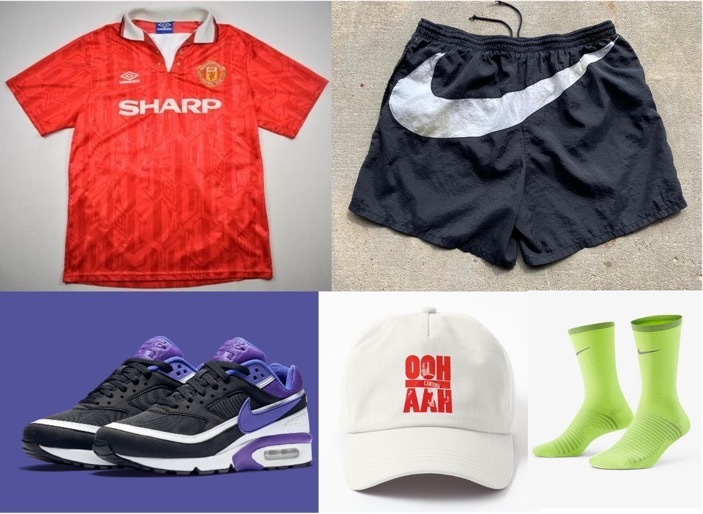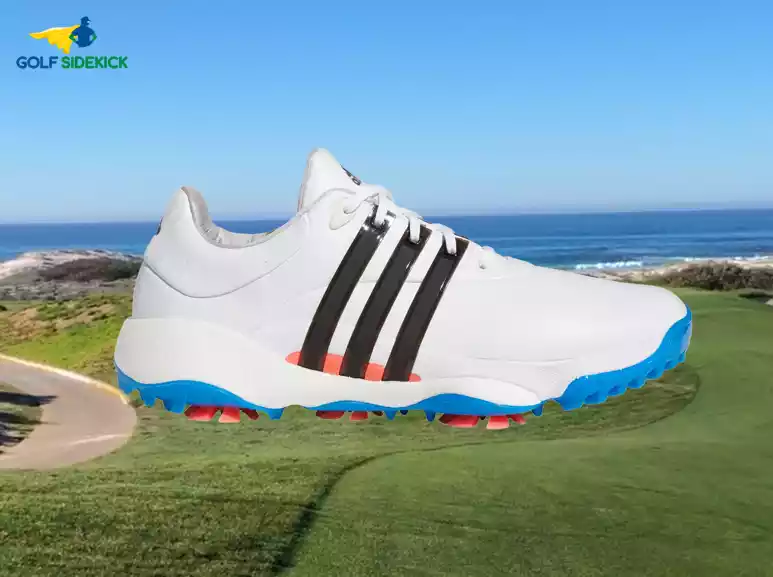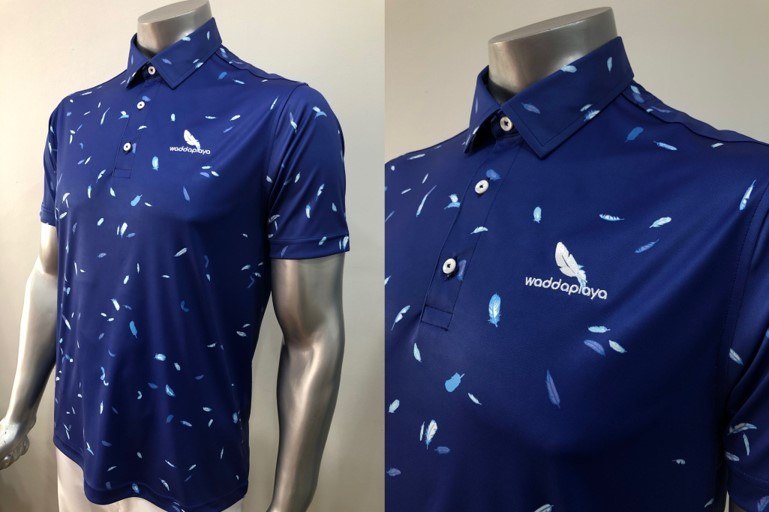Last Updated on January 16, 2024 by Matt Greene
I was a member of, and played at my local small-town course which didn't care much about dress code. Jeans and T-shirts were the norm, shorts without belts were fine. Even a soccer jersey was acceptable. I was from podunkville.
I went up to a big city as a newbie golfer and found all the famous championship courses I'd read about and planned on playing them one by one. I settled on the first one, which my cousin worked at, and made sure to put on my best golfing outfit, collared shirt and all.
'You can't play here wearing that, the members will go crazy' my cousin told me. The shock ran through me like an earth tremor. How could I be turned away in my fancy new golfing outfit - I had no idea what to wear golfing for the first time!

I was wearing a gifted Manchester United soccer jersey and Nike shorts with a big Swoosh on the ass, with Nike Air shoes that a friend gave me as hand-me-downs.
My cousin did tell me how I was supposed to dress and after seeing some of the more experienced golfers around, I realized the error of my ways.
I immediately went out and bought the stuff I needed and was playing on that very same golf course the next day. A golf course Ernie Els and Vijay Singh regularly stopped at!
So to avoid similar embarrassment for you, I've put this little guide together so you never get turned away from a golf course dressed like a fool...
What to wear golfing for the first time - 5 things
You can use a long sleeved or a short sleeved polo shirt but it must have a collar.
Depending on whether you live in a warm or cool climate, the material you use will affect how you feel on the course.
In cooler areas, cotton is always great while in warmer and more humid areas, a synthetic material will let sweat evaporate and keep you dry and cool.
I highly recommend WADDAPLAYA polos especially if you play in a warm climate. All are designed for maximum comfort with many designs, colors and patterns.
Don't be like me and wear a thick cotton shirt in 100 degree Fahrenheit weather and end up lying on the shower floor eating dried mango and drinking the shower water! The first lesson I learned playing in a hot country, was to NEVER wear chinos and a cotton polo - your head feels like it's going to explode!
No-no's
- No T-shirts or sports jerseys
- No big banner advertising across the back or front
- No foul language in massive letters
2. Shorts or slacks
Depending on your preference, you can choose between shorts and slacks. Keep in mind, they need belt loops. No drawstring or soccer shorts.
What pants to wear golfing?
You can also get shorts and slacks made specifically for hot weather or temperate weather like the shirts above.
For hot and humid conditions, I love Under Armour for slacks and waddaplaya for shorts.
For when I travel to cooler more temperate places, I like flat-front chinos and chino shorts.

The safest colors for your golfing pants and shorts are cream, beige, khaki, gray and tan. White and pink as well as very bright colors are something you graduate into as you move up the golf hierarchy and establish yourself as a flashy snappy dresser.
If you wear white trousers and your handicap is not below 3, you will be ridiculed. I promise, just trust me on this one! Be the grey man and stick to the safe shorts colors for now.
No-no's
- Don't wear white pants - reserved only for pretentious low handicappers - identify the white pants guy then don't play with him.
- Don't wear three-quarter length shorts - looks like a noob and often not allowed.
- Don't wear draw-string shorts - they may not be allowed, but shorts with belt loops and a belt are always accepted.
3. Golf Shoes
You get three kinds of golf shoes now.
- Steel spikes - used by the pros and won't be allowed on the majority of standard courses for amateurs - AVOID - these are banned almost everywhere except for the PGA Tour.
- Soft spikes - Steel spikes are replaced with plastic and rubber ones to avoid tearing up greens - these are the most popular type of shoe
- Spikeless - The sole of the shoe has lots of small rubber studs that are great for people who get stud pressure walking on spiked golf shoes.

What shoes do you wear golfing?
I played with soft spike golf shoes for 14 years but as someone who suffers from serious stud pressure playing any sport, I ditched them for spikeless as soon as spikeless became a 'thing'. Just 18 holes killed my feet in soft spikes - the soles are often very hard and only get softer as you spend more and more money on them.
Adidas and Skechers as well as TRUE Linkswear make some of the most comfortable spikeless golf shoes around. After 18 holes in massive heat, I'm usually sitting in the club house sipping my beer, feeling fantastic! The soles are softer as well as having ample padding in the heel and quarter sections - like wearing trainers.

While spikeless golf shoes are more comfortable, they look more casual and like sneakers so you won't look like your favorite pro (unless Freddie Couples or Ernie Els are your favorite). If you want to look like Jordan Spieth or Dustin Johnson, you'll need to get some soft spike golf shoes.
No-no's
- No trainers
- No flip flops, thongs, sandals
- Never ever buy steel spikes
4. Belts and socks
Use your belt loops! Wear a belt. It can be whatever looks good but preferably something stretchy and less formal than the belts you wear at work. I like them to match my shorts or a color of the shoes.
When it comes to socks, you want to get white socks.
5. Extra accessories
Hat or cap
If you're like me, getting a little thin on top or just don't want to get burnt, there are numerous options for headwear. Here are some hats you can use:
- Baseball caps - the most commonly seen hat on Tour and most golf courses. Check out the waddaplaya caps here.
- Visors - Not as popular but great for not getting 'hat hair'. Not good for bald guys
- Cowboy hats - Less common but you know he's a maverick
- Bucket hats - A very common hat for all-round sun protection. Not bad looking with a narrow brim - this is my first choice of hat for sun protection
- Wide brim hats - the mark of a beginner. While very effective in keeping sun off your cheeks, steer clear of these hats if you don't want to look like a newbie. Check out the waddaplaya bucket hats here.
No-no's
- No backward caps - 90% of golfers are not keen on this
- No caps in the clubhouse or bar - old tradition but best to stick to it so they don't make you pay for the clubhouse drinks
Golf glove
These are optional but if you play long enough, you'll eventually use one. The key is to find the right size and remember something very important!
Right handed golfers wear gloves on the left hand and left handed golfers wear gloves on the right hand. You only ever wear one BUT if you want to look like a total beginner, you can wear two, one on the right and one on the left. But please don't!
There are many things to know about golf gloves but that's something for the future. For now, the best glove for you will be durable and cheap. No need to spend massive amounts on gloves just yet.
Below are the Grip Boost Second Skin gloves for hot humid weather (you'll need 3 to alternate with during the round) and the MG Dynagrip for temperate climates. Superb value for money!
What do golfers wear?
Do you need to wear golf clothes to a driving range?
Mostly no. If the driving range is at the actual course and is near the clubhouse, it may require you to wear golfing clothes. But if it's anything else like Top Golf or a standalone driving range, you can hit balls in any clothes you like. There is no need for collared shirts and golf trousers.
I do suggest playing in your chosen golf shirts and also your golf shoes so you practice in the same gear you play in. Shorts and hat won't make much difference, but the tightness of the shirt, and where the seam lies on your shoulder can affect your turn so you should wear the shirts you play in.
The shoe height also makes a difference for practicing. So if you practice putting and hitting balls, use your golf shoes so you're literally practicing for the golf course and the exact height you stand, and distance form the golf ball.
Do you have to wear a collared shirt for golf?
Most of the time yes. There are municipal courses everywhere that do not require you to wear a collared shirt. But if you want to be on the safe side, you should wear a collared shirt because it is guaranteed to be accepted at every golf course. When we talk about a collared golf shirt, we mean a collared polo shirt. You can wear a full button-down dress shirt as well but a polo will be accepted at every golf course.
No golf course will turn you away if you wear a standard collared golf polo.
What to wear golfing if you don't have golf clothes?
Maybe you need to play golf occasionally for work or a surprise round with new colleagues. Often these rounds or meetings will be at high end country clubs or members golf courses where there are golf clothes etiquette rules. There's an easy solution for you, do not fear:
- You can wear ANY work trousers or chinos on the course or in the clubhouse.
- You can wear ANY work shirt with a collar and buttons or ANY collared polo shirt without big printed logos on it. This is on the course, or in the clubhouse.
- You can cover a T-shirt with a sweater or zip up jumper. I have actually played golf without a collared shirt, but I had to keep my sweater zipped up to the top like a turtle neck. No one is going to ask you to look INSIDE your sweater.
- Most pro shops or golf course shops will have everything you need to play on the course. The prices will be inflated but if you have to play a course out of the blue, their pro shop should have everything from shoes, to shorts to shirts and socks.
Can you wear shorts to golf?
If you want to wear shorts to golf, you can. Amateurs can wear long or short pants. They should have belt loops on them though so avoid sweatpants, running shorts or most drawstring exercise shorts. There is no rule in amateur golf to play in trousers. Professionals on the Tour need to play in long pants but amateurs can wear shorts even in national competitions.
Final thoughts
That's a pretty good start to your golfing journey. Key things to remember when golfing for the first time are to have fun and not worry too much about what other people think. Cover your bases by knowing the rules and etiquette and dress in a way that makes you feel good. You may want to learn about the terminology we use in golf so you sound like a pro golfer asap!
Once you do all that, you're ready to hit the course and make some new friends. Golfers seem elitist and snobby from a distance but you'll find once you're in our little "club", you're just another one of the boys.
And any of the ones who make you feel unwelcome....F*** 'em. You'll find your tribe.
Enjoy!

